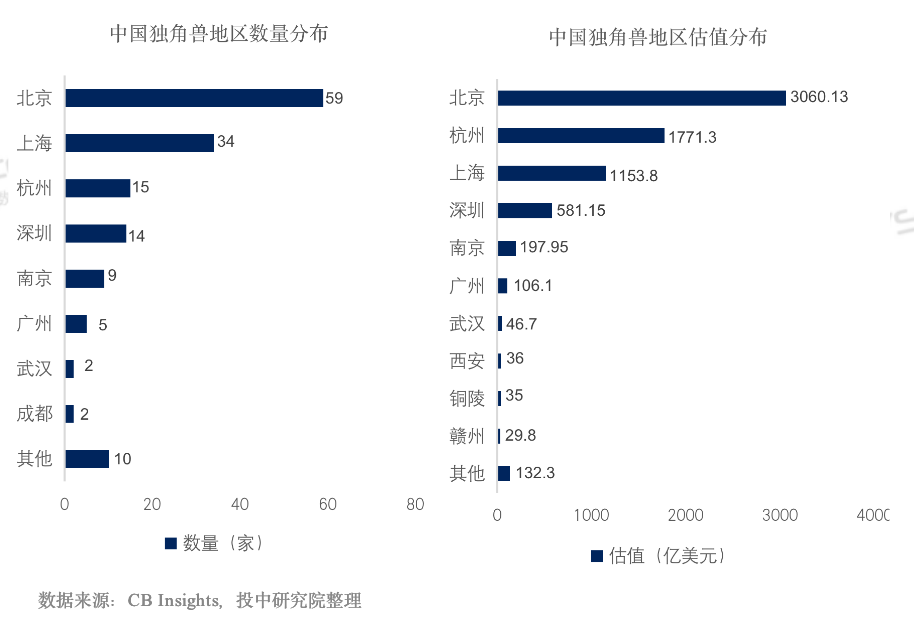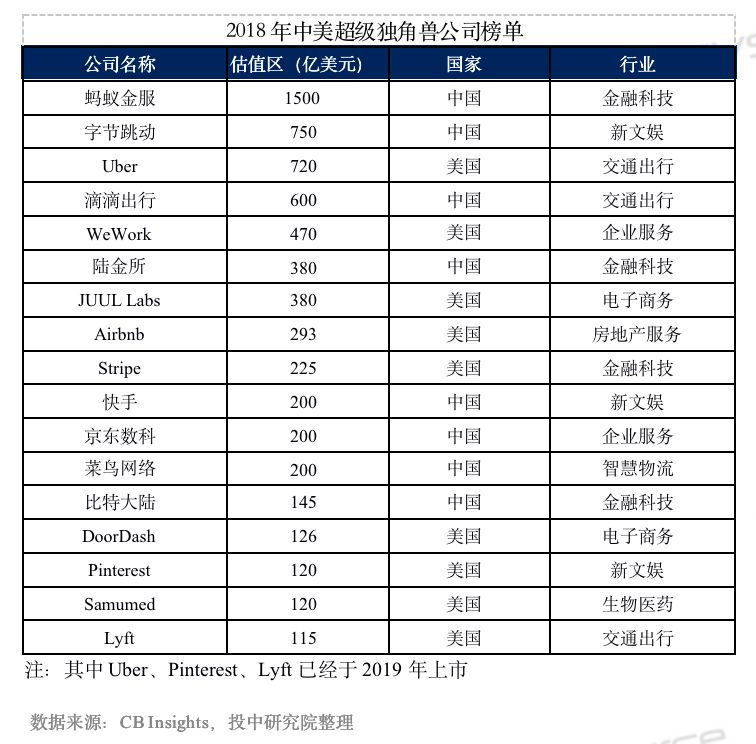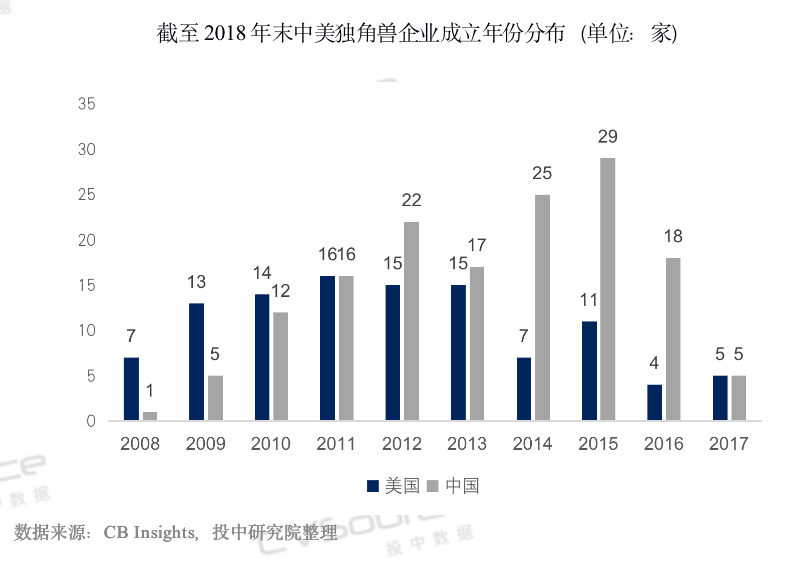As the world’s two largest economies, China and the United States have the largest number of unicorn companies.
Editor’s note: This article is from WeChat public account “Beyond J Curve” ( ID: beyond.jcurve), the author is casting a research institute.
“Unicorn”Company, a startup that has been listed as a private equity or open market investor or institution with a valuation of more than $1 billion and has not been listed for less than 10 years. After the concept of “Unicorn” was put forward, it was quickly recognized by the global investment field and widely adopted. At the same time, the attention and the “gold-sucking” ability of the startups that were titled “unicorn” were significantly improved. . As the world’s two largest economies, China and the United States have the largest number of unicorn companies. In view of the development of the unicorn enterprises in the two countries, Investing in the Institute conducted data comparison and analysis.
01 The Chinese and American unicorns account for nearly 80%, and the number of Chinese has surpassed the United States
< Strong>Global unicorns are mainly concentrated in China and the United States, accounting for nearly 80%. The China Research Institute found that there were 326 unicorn companies worldwide by the end of 2018. Among them, there are 150 in China and 107 in the United States. The proportion of China and the United States is 78.83%, which still occupies an absolute advantage. For start-ups, this means that China and the United States have better entrepreneurial investment and financing environments.
The number of Chinese unicorns has surpassed the United States. According to the statistics of the Investment Research Institute, as of December 31, 2018, there were 150 unicorn companies in China with a total valuation of 715 billion US dollars and an average valuation of 4.767 billion US dollars. In the global unicorn data tracked by CB Insights, a US venture capital research institution, the statistics on American unicorns have been included in the unicorns for more than 10 years. In this report, in order to better reflect the global unicorn companies in the past 10 years For the development situation, we use narrow caliber statistics. Therefore, the Investment Research Institute removed the overage unicorn on the basis of the statistical data of CB Insights, a US venture capital research institution.After the Beast found that as of December 31, 2018, the number of American unicorn companies was 107, with an overall valuation of $468.6 billion and an average valuation of $4.379 billion.
The number of Chinese unicorns has surpassed that of the United States. There are two main reasons for this: First, China has a large population base and a large and vast market. This provides natural conditions for the breeding of unicorns, especially in industries such as e-commerce, transportation, and logistics. Second, the Chinese unicorn is greatly influenced by capital. Relying on government funds and a single fund from large companies such as BAT can reach the valuation threshold for unicorns. According to statistics, nearly 50% of Chinese unicorn companies have investments in Tencent, Alibaba or Baidu.
02 Distribution of Chinese and American Unicorns: China concentrates on the north and the east, and concentrates on the Bay Area, New York
Contrast The regional distribution of Chinese and American unicorns, we found that unicorns are mostly born in areas with relatively mature entrepreneurial ecosystems. The industries and populations in these areas are highly intensive, with significant advantages in capital, technology and talents, and strong policy support. Venture enterprises are likely to form clusters.
Chinese unicorns are still concentrated in Beijing, Shanghai, Hangzhou and Shenzhen. The total number of enterprises in the four regions accounted for 81%, and the total valuation accounted for 91.83%. Among them, 59 in Beijing accounted for 43.7%, with a total valuation of 30.061 billion yuan; followed by 34 in Shanghai, accounting for 25.2%, with a total valuation of 115.38 billion yuan. Hangzhou and Shenzhen are followed by 15 and 14 respectively, but the total value of the Hangzhou area is as high as 177.13 billion US dollars, even surpassing Shanghai. This is mainly because of the high valuation of unicorns in the Hangzhou area. Exist, contributing a $150 billion valuation. In general, these four cities have developed economies, strong scientific research strength, sufficient talent reserves, high policy preferences, and a superior venture capital environment.
At the same time, some unicorns have also been born in emerging cities such as Nanjing, Guangzhou and Wuhan. In recent years, these cities have created powerful conditions for entrepreneurs to broaden their entrepreneurial financing channels, entrepreneurial rewards, and talent retention. The data on venture capital in Nanjing is particularly eye-catching. A total of 9 unicorn companies have been recorded, ranking fifth in terms of quantity and valuation. In 2018, it was the first year for Nanjing to promote the construction of an innovative city. Under the support and guarantee of the “121” strategy and the “1+45” policy system of Document No. 1, Nanjing’s annual high-tech enterprises increased by 128.2, an increase of 70%, a total of 3,126; the number of new science and technology enterprises increased by 24,000, an increase of 17%; a total of 208 new R&D institutions that have signed up for market operation, including 108 officially filed, incubating and introducing enterprises 951 homes.
The US unicorns are mainly concentrated in California (73 in the West Coast) and New York (11 in the east), followed by Massachusetts (8) and Illinois (4). The West Coast of the United States, especially the San Francisco Bay Area in California, relies on the development of high-tech companies in Silicon Valley, attracting the world’s top scientific and technological innovation talents, a total of 38 unicorn companies, accounting for 52% of the entire state of California. High-tech incubators built by surrounding universities and research institutes and governments provide natural conditions for the birth of unicorns. At the same time, the Bay Area’s policy support for innovative enterprises, developed venture capital, and improved industrial layout are also important reasons for the San Francisco Bay Area to lead the world’s unicorns. As the top city and economic center in the United States and the world, New York has a significant advantage in capital and technology.
03 The Chinese and American unicorns are all based on small valuations, and the Super Unicorn is different.
The China Academy of Sciences will divide the Sino-US unicorns into US$1 billion to US$2 billion, US$2 billion to US$5 billion, US$10 billion and US$10 billion, and will be the 2018 Sino-US unicorn. Statistics were made on the distribution of each segment, with the outer ring being China and the inner circle being the United States. Through the chart, we can find that the unicorn enterprises in China and the United States are mainly concentrated between the value of 100-200 million, with 89 in China and 67 in the United States, accounting for 59% and 63% respectively. Followed by a valuation of 2 to 5 billion, each accounting for 29% and 23%. The unicorn company with a valuation of 5-10 billion US dollars has 9 in China and 6 in the United States, with similar proportions.
A company with a valuation of more than $10 billion is called a super unicorn. Compared to companies that have just reached the threshold of the unicorn, the Super Unicorn has a considerable market size and technical moat. They are also the epitome of a country’s emerging companies. According to the statistics of the Institute of Investment, as of the end of 2018,There are 8 super unicorns with a national valuation of more than 10 billion US dollars, including Ant Financial ($150 billion), Today Headlines ($75 billion), Didi Travel ($60 billion), Lujin Institute (38 billion), fast hands (20 billion US dollars), Jingdong Digital (20 billion US dollars), rookie network (20 billion US dollars) and Bitian mainland (14.5 billion US dollars).
As of the end of 2018, there were 9 super unicorns with US valuations exceeding US$10 billion, namely Uber ($72 billion), a transportation company, and WeWork ($47 billion), a joint office leasing company, JUUL, an electronic cigarette company. Labs ($38 billion), home-based short-term rental company Airbnb ($23.9 billion), online payment company Stripe ($22.5 billion), takeaway company DoorDash ($12.6 billion), picture social company Pinterest ($12 billion), biopharmaceutical company Samumed ($12 billion) and transportation travel company Lyft ($11.5 billion).
In the field of head unicorns, Chinese companies seized the financial technology and new entertainment circuits, and the United States was evenly distributed. According to the data, among the super unicorn companies with a scale of more than 10 billion in China, 3 are financial technology companies and 2 are in the new entertainment industry. In contrast, the nine super unicorns in the United States are distributed in seven industries: transportation, business services, e-commerce, real estate services, financial technology, new entertainment, and biomedicine. The value is also relatively lower than the Chinese super unicorn.
04 It takes an average of 6 years for the United States to breed a unicorn, and more “accelerated” unicorns in China
From As can be seen in the figure, the establishment of the American unicorn company was concentrated in 2009-2013, which was established between 5-8 years. The most concentrated year of Chinese unicorn companies was 2012-2016, which was established between 2-6 years.
Based on the year of establishment of the unicorn, the average age of Chinese unicorn companies is 4.72 years, and the average age of the United States is 6.07 years. And established in the Chinese unicorn enterpriseThere are 76 companies with a life of less than 4 years, accounting for 50.66%. More than 23 unicorn companies formed in two years, accounting for 15.33% of the total, while the United States established only less than two years of unicorn companies accounted for only 8.41%. The growth rate of Chinese unicorn enterprises is becoming more and more rapid. On the one hand, it shows that capital has been increasingly competitive in some potential enterprises, but on the other hand, it shows that Chinese unicorn enterprises have a certain degree of valuation bubble. .
05 Unicorn industry distribution: Focus on corporate services, explore new technologies, new models
In 2018, there were 19 industries in China with unicorn companies. The number of unicorns in the top three enterprise service, e-commerce and smart logistics industries accounted for 32.67% of the total. It shows that these three industries have large market capacity in China, and their development tends to be mature, and they are closely watched by capital. The United States’ unicorn companies are spread across 19 industries, the top two being the corporate services and financial technology industries, and the third in the e-commerce, new entertainment and healthcare industries.
From the perspective of the overall distribution of the Chinese and American industries, the rise of the new economy has become a major development trend. The new economy is based on new technologies and uses information data to make a systematic major transformation of the traditional economy. In this process, with new industries, new formats, and new business models as the starting point, the company’s operational efficiency is improved, social resource allocation is optimized, and a positive cycle of high-quality economic development is achieved.
Enterprise Service is Sino-US The industry in which the unicorns of the two countries are the most concentrated, the number and proportion of American unicorns in this field is still relatively leading. Enterprise Service Unicorn relies on strong software strength and technical advantages to provide platform-based services and technical support for enterprises in different fields. Chinese companies serving unicorns accounted for about 11%, with an average valuation of about $3.3 billion. This includes a large number of artificial intelligence companies, through voice recognition, face recognition, digital technology, deep learning, etc., to provide enterprises with smart healthcare, smart education, smart city, smart home and other quality and efficiency solutions. US corporate services unicorns account for about 24%, with an average valuation of $4 billion. The development of these unicorn companies tends to be vertical and penetrates into more subdivisions.The field includes technology sales, human resource management, advertising technology, restaurant management, design collaboration, and home service platforms. The top US-based service unicorns have joint office WeWork ($47 billion), “US version” Slack Technologies ($7.1 billion), and restaurant management platform Toast ($2.7 billion).
E-commerce benefits from consumption upgrades and business model innovation, and is also an industry where Chinese unicorns gather. China’s e-commerce unicorns accounted for more than 11% of the US, with an average valuation of about $2.1 billion. Among them, the new retail of automobiles has redefine the way of buying cars through the modes of automobile e-commerce platform, automobile supermarket, automobile consumption financial platform, etc. The vehicles are much better than the big search vehicles with the valuation of 6.6 billion US dollars and 3.5 billion US dollars respectively. The first two of the beast valuation. In comparison, the US e-commerce unicorn accounted for only 6%, with an average valuation of $1.37 billion. The highest valuation is the “US version of the United States”, established in 2010, with a valuation of $3 billion.
In other industries, the layout structure of Chinese and American unicorns has its own focus. For example, China has a large number of layouts in the fields of smart logistics (15), new entertainment (14), new energy vehicles (14), and big data/cloud computing (11), surpassing the United States. Financial technology (15) and medical health (7) are the main force directions of American unicorns, both in terms of quantity and proportion.
China The main venture capital cities have different characteristics and focuses on the distribution of the industry. Beijing’s unicorn companies are mainly focused on corporate services, big data/cloud computing, e-commerce and new entertainment. Shanghai’s unicorn companies focus on areas such as smart logistics, e-commerce, Internet education, and new energy vehicles. Shenzhen Unicorn is mainly focused on high-tech industries. The three major areas of focus are financial technology, smart logistics and intelligent hardware. The industry distribution of Hangzhou Unicorn is relatively even, and it is distributed in many industries such as big data/cloud computing, e-commerce, financial technology, new energy vehicles, new entertainment, and smart logistics.
Overall, although the number of unicorns in China has surpassed that of the United States, the structure still needs to be optimized. Problems such as unicorn regions, uneven distribution of industries, and high valuations still exist. The China Academy of Sciences is expected to have a more stable growth in the Chinese unicorn in the next few years. At the same time, considering the contradiction between the huge growth space of the Chinese consumer market and the inefficiency of traditional consumer services, Internet-dependent industries such as e-commerce will still dominate the Chinese unicorn. Of course, we should also see China under the changes in the internal and external environment and the increase in research and development expenditure in recent years.There will be more unicorn companies with technological advantages.
What is most noteworthy is that due to the favorable policy of China’s science and technology board, it is expected that the unicorn enterprises in the six fields that KCC will focus on will usher in faster development, including the new generation of information technology, high-end equipment, and new Materials, new energy, energy conservation and environmental protection, and biomedicine. The Shanghai Stock Exchange announced the five sets of market capitalization indicators for the initial public offering of the board, set up a variety of inclusive listing conditions, pay more attention to the technological innovation capability of the enterprise, and allow enterprises that meet the position of the science and technology board, have not yet made a profit, or have accumulated unrecovered losses in the science and technology. Board listed.
At present, China’s biomedicine, artificial intelligence, big data, cloud computing and other industries have already seen more unicorns and are concerned by various capitals. It is expected that in the future, various vertical segments will be expected to usher in new breakthroughs. Technological innovation and business are going hand in hand. The establishment of the science and technology board is conducive to the listing and exit of some unicorn enterprises. It is expected to further promote the development of strategic emerging industries. The valuation of those unicorn enterprises that have real core competitiveness is also expected to be supported and boosted.








